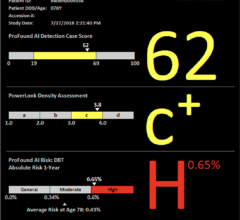May 4, 2011 – Researchers from the University of Cincinnati presented results from a prospective study at the American Roentgen Ray Society 2011 annual meeting this week, demonstrating how positron emission mammography (PEM)-guided biopsy may expedite pre-operative work-up and reduce radiation exposure for breast cancer patients.
PEM scanners are high-resolution breast PET systems that can show the location as well as the metabolic phase of a lesion. This information is critical in determining whether a lesion is malignant and influences the course of treatment. Naviscan’s Stereo Navigator Accessory is the first commercialized PET-guided biopsy tool and has been U.S. Food and Drug Administration (FDA)-cleared since 2008.
"PEM is useful for performing local staging in women with newly diagnosed breast cancer,” said Amy Argus, M.D., assistant professor of radiology and one of the lead investigators of the study. “When additional breast abnormalities are identified by PEM, accurate PEM-guided biopsy can be performed on the same day as the diagnostic imaging, which decreases the patient's radiation dose and may expedite their preoperative work-up."
In this study, 18 women with breast cancer classified as BIRADS 5 identified on mammography or ultrasound underwent a PEM scan and same day PEM-guided biopsy on 24 index and satellite lesions. Lesion size was 4-60 mm with a mean size of 16 mm. Results were concordant for 83 percent of lesions and discordant for the remaining due to patient movement and operator experience. PEM is the only technology where physicians are able to biopsy on the same injection of the radiotracer. This is because the radiotracer utilized, FDG, does not washout of the tumor as with other blood flow-dependant modalities like MRI or BSGI. By avoiding a double injection of radiotracer, the radiation exposure to the patient and medical personnel is reduced. Same day procedures are also feasible with PEM given the ease of interpretation compared to other advanced imaging modalities.
For more information: www.naviscan.com


 July 29, 2024
July 29, 2024 








